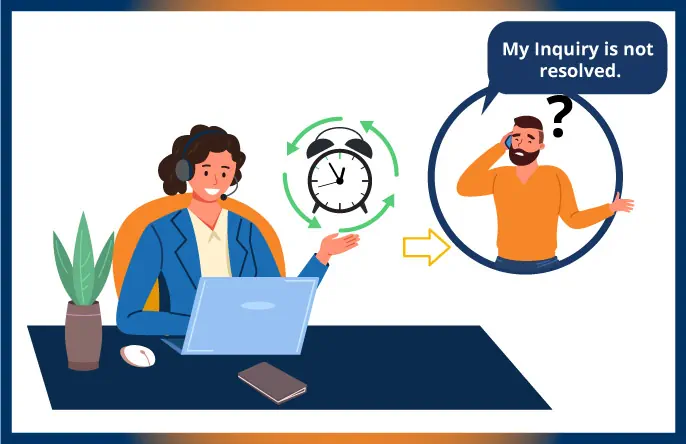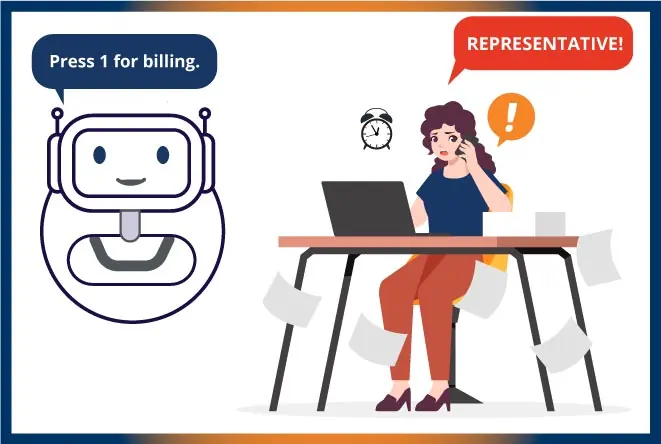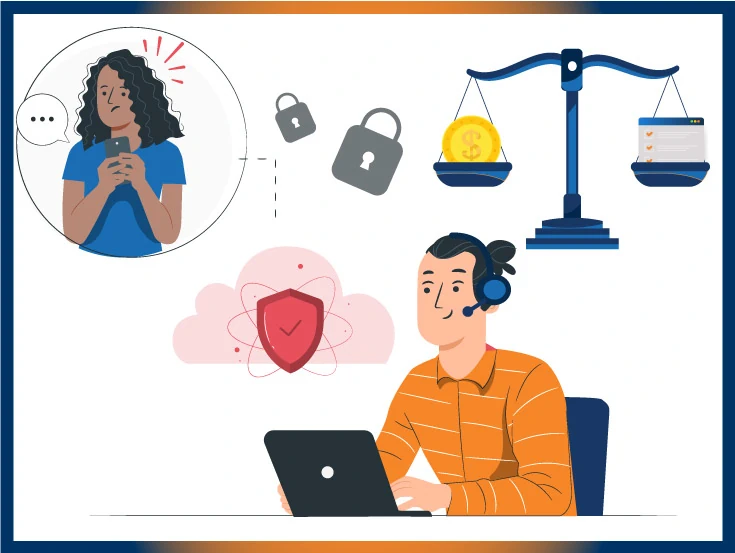Call centers are under constant pressure to deliver fast, efficient, and cost-effective customer service. In the rush to meet targets, leaders often rely on industry “best practices” or long-standing assumptions that seem logical on the surface.
But here’s the problem: many of these so-called best practices are myths—outdated ideas that actually hurt customer experience (CX) rather than help it.
These myths can lead to frustrated customers, disengaged employees, and higher operating costs. By exposing and challenging them, call center leaders can create strategies that improve both customer satisfaction and loyalty while also strengthening agent performance. Let’s look at some of the most common call center myths that may be holding your CX back.

Myth 1: “Customers Care Most About Short Wait Times”
Many call centers obsess over reducing Average Speed of Answer (ASA), believing that faster answers automatically translate into happier customers.
However, while nobody likes to wait on hold, most customers care far more about whether their issue gets resolved on the first call. In fact, SQM research consistently shows that First Call Resolution (FCR) is the strongest driver of customer satisfaction and loyalty. A customer will tolerate a few extra minutes of waiting if it means they don’t have to call back.
When call centers prioritize speed over resolution, agents may feel pressured to rush customers off the line. This often leads to incomplete problem-solving, repeat calls, and even escalations—driving up costs and lowering satisfaction.
Instead of focusing only on ASA, shift attention to metrics like FCR and call quality. Give agents the time, training, and authority to fully address customer issues, even if it means calls take slightly longer. Customers remember the relief of a resolved problem much more than a short wait time.


Myth 2: “More Scripts Equal Better Consistency”
Scripts are often seen as the safest way to guarantee compliance, professionalism, and consistency across customer interactions. Some leaders believe that the more scripted the conversation, the fewer mistakes agents will make.
In reality, over-scripting easily backfires. Customers can instantly tell when an agent is reading from a script—it feels robotic, inauthentic, and impersonal. Agents, too, can become disengaged when they’re treated like reading machines rather than problem-solvers.
Rigid scripting limits empathy and personalization, both of which are key to building trust. Customers may feel like they’re not being heard, which damages loyalty. Meanwhile, agents miss the chance to develop real communication skills and confidence.
A better approach is to use scripts as flexible guidelines rather than word-for-word instructions. Train agents in positive scripting, where they’re given helpful phrasing, tone suggestions, and guardrails—but still have room to adapt based on the customer’s needs and emotions. This balance supports compliance while empowering agents to build authentic connections.

Myth 3: “Self-Service Will Replace Live Agents”
With the rise of chatbots, knowledge bases, and AI-driven IVR systems, some leaders assume self-service is the future and live agents will become obsolete.
The truth is that self-service is valuable—but only for simple, transactional needs. Customers still turn to live agents when issues are complex, emotionally charged, or require nuanced problem-solving. No matter how advanced automation becomes, it can’t fully replicate empathy or the reassurance of speaking to a real person.
Over-reliance on automation often frustrates customers who feel trapped in endless self-service loops, unable to reach a human. This frustration damages trust and can even push customers to competitors.
Instead, treat self-service as a complement, not a replacement. Automate simple tasks like balance inquiries or password resets but design smooth transitions to live agents for more complex problems. This way, you deliver convenience without sacrificing empathy or resolution quality.


Myth 4: “Customer Satisfaction Is the Same as Customer Loyalty”
Many organizations assume that if a customer is “satisfied” with their call, they will remain loyal to the company long-term.
However, satisfaction and loyalty aren’t the same. A customer can walk away from an interaction feeling satisfied yet still switch to a competitor who offers better prices, convenience, or experiences. Loyalty requires more than satisfaction—it requires trust, emotional connection, and consistently positive outcomes across multiple interactions.
If leaders rely only on satisfaction surveys, they may miss signs of churn risk. This false sense of security leads to lost customers and missed opportunities for improvement.
A better approach is to go beyond measuring satisfaction by tracking metrics like Net Promoter Score (NPS), Customer Effort Score (CES), and churn data. Pair these insights with qualitative feedback to understand the deeper drivers of loyalty. Use this knowledge to create proactive strategies that strengthen long-term customer relationships.

Myth 5: “High Call Volumes Mean Agents Should Work Faster”
When call queues grow, the instinct is to push agents to handle calls more quickly. Leaders often assume speed equals efficiency and that faster calls will reduce backlog.
The reality is that rushing agents rarely improves efficiency. Instead, it often reduces FCR, as agents may cut corners, miss details, or fail to address root causes. The result? More repeat calls, escalations, and frustrated customers. What looks like efficiency in the moment ends up increasing workload and costs in the long run.
Customers sense when they’re being rushed, and it erodes trust. Agents also feel stressed and undervalued, leading to burnout and higher turnover. Together, this creates a cycle of poor customer experiences and rising operational costs.
The solution is to balance speed with quality. Invest in workforce management tools to forecast demand and staff accordingly. Provide agents with training, resources, and authority to resolve issues thoroughly—even if calls take a little longer. The payoff is fewer repeat calls, happier customers, and a more sustainable workload for your team.


Myth 6: “Happy Employees Don’t Affect CX That Much”
Some call center leaders believe that as long as processes are solid and metrics are met, employee engagement doesn’t have a direct impact on customer experience.
However, employee satisfaction and customer experience (CX) are deeply connected. Disengaged or burned-out agents struggle to deliver empathy, patience, and problem-solving. On the other hand, engaged employees bring energy and care to their interactions—qualities customers notice and appreciate.
Neglecting employee well-being leads to high turnover, inconsistent service, and declining morale across the team. Customers end up speaking with frustrated or inexperienced agents, which undermines trust and loyalty.
Employee satisfaction should be treated as a strategic priority. Recognize and reward great performance, provide clear career paths, and give employees the tools they need to succeed. Simple actions like listening to agent feedback, offering flexible scheduling, and celebrating achievements go a long way toward boosting morale. When employees feel supported and valued, they naturally provide better service—and customer satisfaction follows.

Myth 7: “Compliance Is Just About Avoiding Fines”
Compliance is often viewed as a legal checkbox—something that protects the company from penalties and regulatory trouble, but not much else.
The truth is that customers care about compliance more than many organizations realize. Issues like data privacy, financial security, and honest disclosures directly affect trust. When agents handle compliance awkwardly or inconsistently, customers may feel uneasy—even if no regulations are technically violated.
A narrow, “box-ticking” approach to compliance can make interactions feel stiff or untrustworthy. Worse, lapses in compliance (like mishandling personal data or skipping required disclosures) can permanently damage brand credibility and drive customers away.
The best solution is to integrate compliance into the customer experience strategy. Train agents to weave compliance seamlessly into conversations so it feels natural rather than scripted. Reinforce why compliance matters not just for the company, but for the customer’s safety and peace of mind. Framing compliance as part of building trust turns it from a burden into a value-add for CX.


Myth 8: “Data Alone Will Fix Your CX”
Companies often make the false assumption that with enough data—customer surveys, call metrics, quality scores—improvements will happen automatically. Leaders sometimes believe that more measurement equals better performance.
The reality is that data is only as valuable as the action it inspires. Collecting endless KPIs without a clear strategy often leads to analysis paralysis. Even worse, focusing on the wrong metrics (like call length instead of resolution) can push behaviors that harm CX.
Overemphasis on data without context overwhelms managers and agents. It can also create frustration when employees feel micromanaged or judged on metrics that don’t reflect customer outcomes. Ultimately, customers suffer when data isn’t translated into meaningful improvements.
Instead, use data as a tool, not a crutch. Prioritize actionable insights, like linking First Call Resolution, customer feedback, and QA scores to coaching sessions and process improvements. Instead of measuring everything, focus on the few KPIs that truly reflect customer loyalty and experience. The goal isn’t more data—it’s better decisions.
